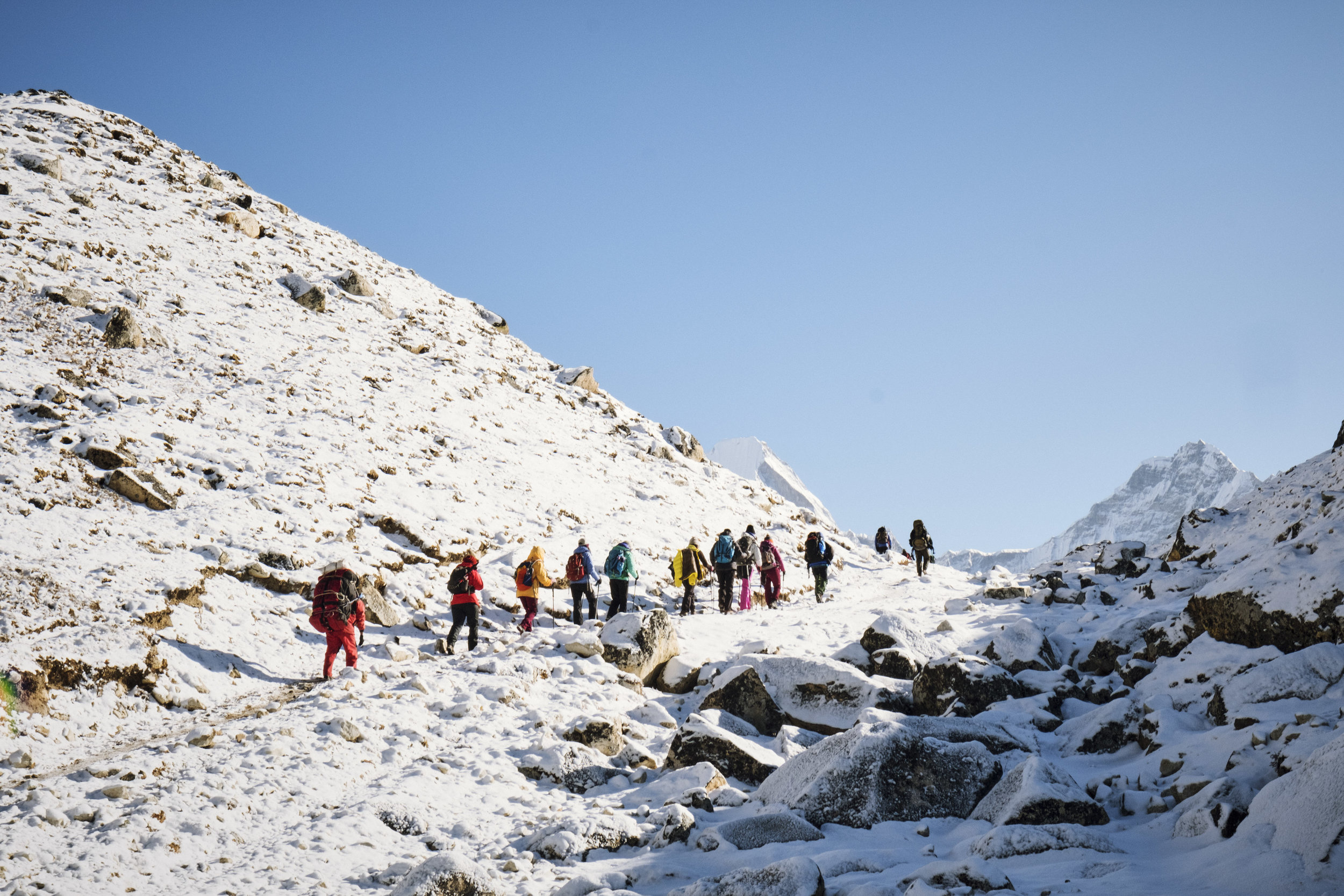10 Tips, tricks & THINGS You'll want to know before your Everest Base camp Trek
BY BRIANA AGUILAR-AUSTIN
Bri is a long distance runner, imbibing expert and yogi (among many other amazing things). These are some things she wishes she knew before she trekked EBC for the first time that she wanted to pass on to future adventurers.
Photos by Ren Fuller
1
Bring cash for treats…
Take the equivalent of about $100 USD in small Nepalese rupees to buy snacks, toiletries and souvenirs along the trail. It supports the local economy, makes a long day of hiking that much sweeter (Oreos are so good at 5,164m), and keeps your duffle and daypack light for the flight to/from Lukla!
You can buy anything along the trail. Nothing like cheddar cheese Pringles and an orange Fanta to cap off an 8-hour day of hiking. However, the higher you go, the more expensive things are. I brought the equivalent of $150 USD in small Nepalese Rupees. Pringles can cost between $5-$10 a can. Trust me, worth it! As you trek, you’ll also understand the intense amount of labor it requires to take anything up the mountain via yak, donkey or superhuman Nepalese porter. This makes the expensive price tag much more reasonable. Plus, buying items from the local shops is a great way to support the mountain economy. Finally, the flights to/from Lukla have very strict weight limits for your duffel (10kg) and daypack (5kg). Buying things on the mountain helps you bring the gear you will definitely need, and buy the treats you will definitely want. Bring an extra bit of money to hit up the highest altitude Irish Pub in the world. Located in Namche Bazaar, you can visit on your second to last day of the hike. A $10 Guinness never tasted so good!
2
From 80° to 10°, and back again.
Layers, layers, layers…
Make sure you bring lots of wicking, merino wool, fleece and down layers. The weather in the Himalayas varies wildly, so be prepared for hot sun, wind, rain and snow. It's very cold in the teahouse bedrooms at night, so bundle up!
On sunny mornings, the temperature would easily hit the high 70os. The clouds rolled in, the winds picked up and the temperature would drop to the 30os. Pack lots of distinct layers: wicking tank or tee, light merino wool long-sleeve, heavy long-sleeve, thick fleece, rain jacket and poncho. I would add or pull off layers at least 3 times a day.
Plan on a super warm, thick fleece outfit to change into when you arrive at the teahouse. The bedrooms aren’t heated and they are always cold. We share meals in a heated common room, but the furnace is not lit until dinner time. If the day is cold, so is the space. Your duffle and daypack space is limited, so everything you pack should be multipurpose. At night, I wore thick fleece pants and hoodie, under an outer shell jacket. This also doubled as my coldest weather outfit on the days we hiked to Base Camp and up to Kala Patthar.
3
There is a lot of downtime, bring something to fill it!
Books, audiobooks, cards, games on your phone… there is quite a bit of time to chill on this trek, make sure you bring something to occupy your time.
From waiting for the flights to and from Lukla, to arriving at teahouses in the early afternoon, there is a lot of downtime. Bring something- a book, kindle or cards to occupy your time. Also, a great playlist and book on tape helps a long day of hiking go by a lot faster!
4
This is a trek. A really long trek.
9 days to EBC & Kala Patthar. 4 days down. Mentally and physically, this is a long and arduous trek, not a summit.
Only a few days on the trail are extremely challenging, either very steep and/or rocky. Most days are “Nepali flat”, rolling hills over well-kept trails. Five to nine hours of hiking a day, every day, for 13 days, in cold weather and high altitude. This is not a summit climb, like Kilimanjaro or Elbrus, where we hit the goal and quickly head back down. On the EBC trek, we hit the "goal" and there are 4-5 more days of hiking. The views are wildly beautiful, the food is good, the company even better, but prepare yourself for a long trek. If Kilimanjaro is like running a marathon, the EBC trek is like running 10 half-marathons in a row. Take your time, rest often, hydrate and eat lots to prepare your mind and body for 13 straight days of hiking.
5
Speaking of eating, eat eat eat!
(Except meat and dairy, skip those…)
Eat as much as you can, often. Eat at meal times and bring lots of snacks on the hikes. It helps keep you healthy and strong for the amazing and long trek ahead.
Hours of trekking and the high altitude will force your body to burn thousands of calories a day. Eating helps you recover your energy. The food on the trek can be delicious as teahouses provide warm and rich meals. However, stay away from meat, dairy and tread lightly at bakeries. Perishable goods travel via plane from Kathmandu to Lukla, then are packed on porters, yaks or donkeys, and finally are brought to the teahouses and bakeries. Although delicious, there is no way to know how long something has been sitting, and refrigeration is not the norm. That is why Pringles, Oreos and other non-perishable snacks are so great to purchase on the trail! I’m all about eating local foods, but wait to try meat, dairy or baked goods until the last couple days of your trip or in Kathmandu. You don’t want your 13-day trek potentially ruined because of a bad cheese sandwich (I speak from experience, woof).
6
Everest Base camp is amazing,
but Kala Patthar is the real gem.
We all signed up for the Everest Base Camp trek to get to Everest Base Camp. And it is amazing! But the day with the most beautiful views of Everest is the optional morning hike up Kala Patthar.
Kala Patthar is a 5,643m “hill” overlooking EBC, with incredible views of Everest, Lhotse and Nhotse. This is an optional hike either the afternoon we get to EBC or the morning after, weather-dependent. The hike up Kala Patthar is far more steep and challenging than the hike to basecamp. We were all exhausted after the basecamp trek, and many people skipped out on Kala Patthar. I went, but stopped about midway to watch the sunrise over Everest. It was truly magical! The sweeping panoramic views of the Khumbu glacier and the surrounding Himalayas were breath-taking. EBC is a great mental and physical goal, but Kala Patthar is the true gem on this trek. Prepare yourself for Kala Patthar as the most challenging “summit” day. It is so worth the effort!
7
Beware the Khumbu CougH
The Khumbu (or high altitude) Cough is caused by low humidity, freezing temperatures and dusty trails associated with high altitude. Do everything you can to avoid it.
The Khumbu cough is a dry, hacking cough that is extremely hard to get rid of, even after leaving Nepal. I had the cough for about 4 weeks after my return. It is inflammation of the bronchial tubes caused by extremely cold weather with very low humidity. Drink warm water or tea as often as you can, suck on throat lozenges, keep your breathing measured (this is hard as we hike up a mountain, to be fair!), wear a buff over your mouth as you hike and even while you sleep if possible.
8
The Himalayas are holy ground
When nature calls, be respectful and remember where you are.
You’ll see many Stupas (Buddhist shrines) and prayer flags along the Everest Basecamp trail. Much of the trail also borders people’s homes and land. Always ask a guide before you veer off the trail to use the bathroom. This is for your safety and so the guide can direct you where to go. Going to the bathroom near a holy or memorial site, or in someone’s backyard is an easy mistake to make, but still in extremely poor taste. Best to let a guide direct you.
9
WATCH YOUR %*@#&! MOUTH
Swearing (in any language) is considered extremely offensive in Nepal. No one will police your speech on the trail, but it is something to keep in mind, particularly as you converse with the guides and porters. We are trekking through their home and it is important we both respect and honor that!
10
There's LITTLE hand-holding here
The guides treat us like the seasoned, experienced hikers that we are, which means if you have a question, problem or concern, tell them!
The guides from Take On Nepal are incredible. They were attentive and warm, responsive to questions or concerns, and always made us laugh. However, there is an expectation of personal responsibility. The guides check on us, but they expect each trekker to speak up if she feels sick, has an equipment issue or has a problem of any kind. Most days, we were spread out along the trail, rather than hiking in one large group. It was great, as it allowed each hiker to go more at her own individual pace. The guides won’t micromanage you, but each hiker must be responsible. Stay on the trail and within eye or earshot of a guide at all times, always tell a guide if you leave the trail to use the bathroom or have to stop for any reason, and speak up if you need assistance of any kind. This is for your safety and the safety of the group as a whole.
The best piece of advice for the EBC trek: enjoy every moment, even the hard ones! It will be cold and challenging, and you will be pushed to your mental and physical limits. Frustration abounds when you are hungry, freezing and exhausted. But those moments challenge us to appreciate the world as it is. The trek is hard, but I am so excited to go back to see our incredible guides, meet more amazing locals, eat delicious food and experience the wild beauty of the Himalayas!







